Côte d’Ivoire overtakes Ghana to become the second largest economy in West Africa.
M. Mbems, Accra
February 20, 2025
Ghana and Côte d’Ivoire have much in common. Similarities include sociological kinship, with a dominant ethnic group, the Akan in the two countries. Along their borders, communities speak the same language despite arbitrary colonial borders that separated them. The two countries have experienced different economic fortunes. Ghana was a failed state under a socialist system and successive military regimes that followed independence. During the same period, Côte d’Ivoire prospered under a French-dominated economy in the 1960s and 1970s until the country’s economy collapsed under heavy public debt in the 1980s. After the death of the first President, Félix Houphouët Boigny in 1993, the country descended into chaos after a failed political transition. Between 2002 and 2010, Côte d’Ivoire went through a tumultuous and devastating civil unrest which turned into full-blown war between 2010 and 2011.
Contrasting economic development
Ghana and Côte d’Ivoire are neighbors and members of the Economic Community of West African States. They are first and second cocoa producers in the world, supplying 20 percent of cocoa to the international markets. They are also modest oil and gas producers. In 2023, Côte d’Ivoire produced 60,000 bpd, while Ghana produced three times more at 174,000 bpd. After 60 years of independence, the two countries continue to experience socio-economic disparities, gender gap, and abject poverty, especially in their respective northern regions.
After the start of oil production in 2010, Ghana took a lead and became a middle income country in 2011. Within a decade, it generated a gross domestic product (GDP) of US$39.34 billion (from US$4.9 billion in 2000). In 2011, the Ghanaian economy was growing at 14.4 percent per years. Ghana seemed unstoppable. During the same period, Côte d’Ivoire’s economy collapsed after a protracted civil unrest. Ghana became the second largest economy in West Africa behind the giant Nigeria..
But since 2020, the situation has reversed and Côte d’Ivoire is now the second largest economy in the ECOWAS region. The country is stretching its lead. If Côte d’Ivoire maintains its current growth momentum, it will have a nominal GDP of US$120 billion by the time Ghana exits its current IMF reform program in 20261.
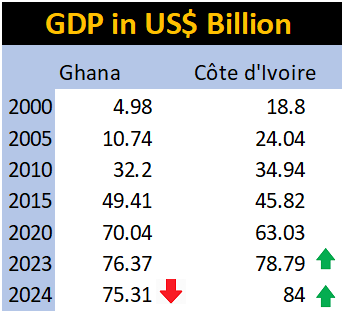
Between 2012 and 2019, the country experienced one of the fastest economic growth rates in Sub-Saharan Africa, averaging 8.2 percent growth per year according to data from the World Bank. The World Bank also notes that between 2021 and 2023, Côte d’Ivoire maintained a resilient trajectory despite global and regional disruptions, posting an average real GDP growth of 6.5 percent2.
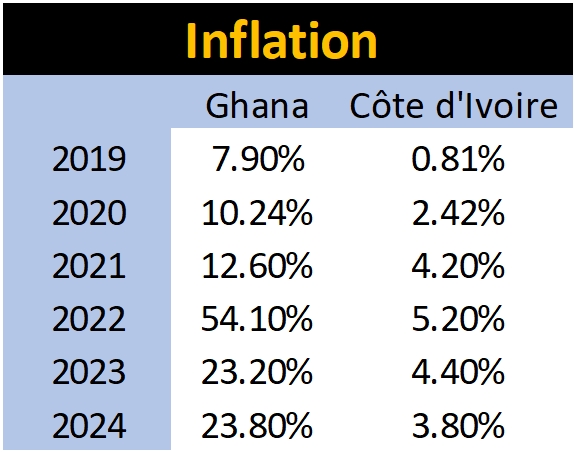
Côte d’Ivoire performance after 10 years of civil war
After the war, the country reorganized its administrative services and integrated the different fighting groups into the regular national army. The goal was to restore peace and reunify a country split into two along regions controlled by warring factions. Then, the country set its sight on the economy, beginning with the reconstruction and modernization of infrastructure. In a decade, Ivorian authorities have invested in road constructions, bridges, power production, and ports. Social safety nets, water supply, information communication technology and rail also recorded sustained investments.
The quality if life of Ivorians has improved and Cote d'Ivoire has the second highest GDP per capita of the Economic Community of West African States (ECOWAS).
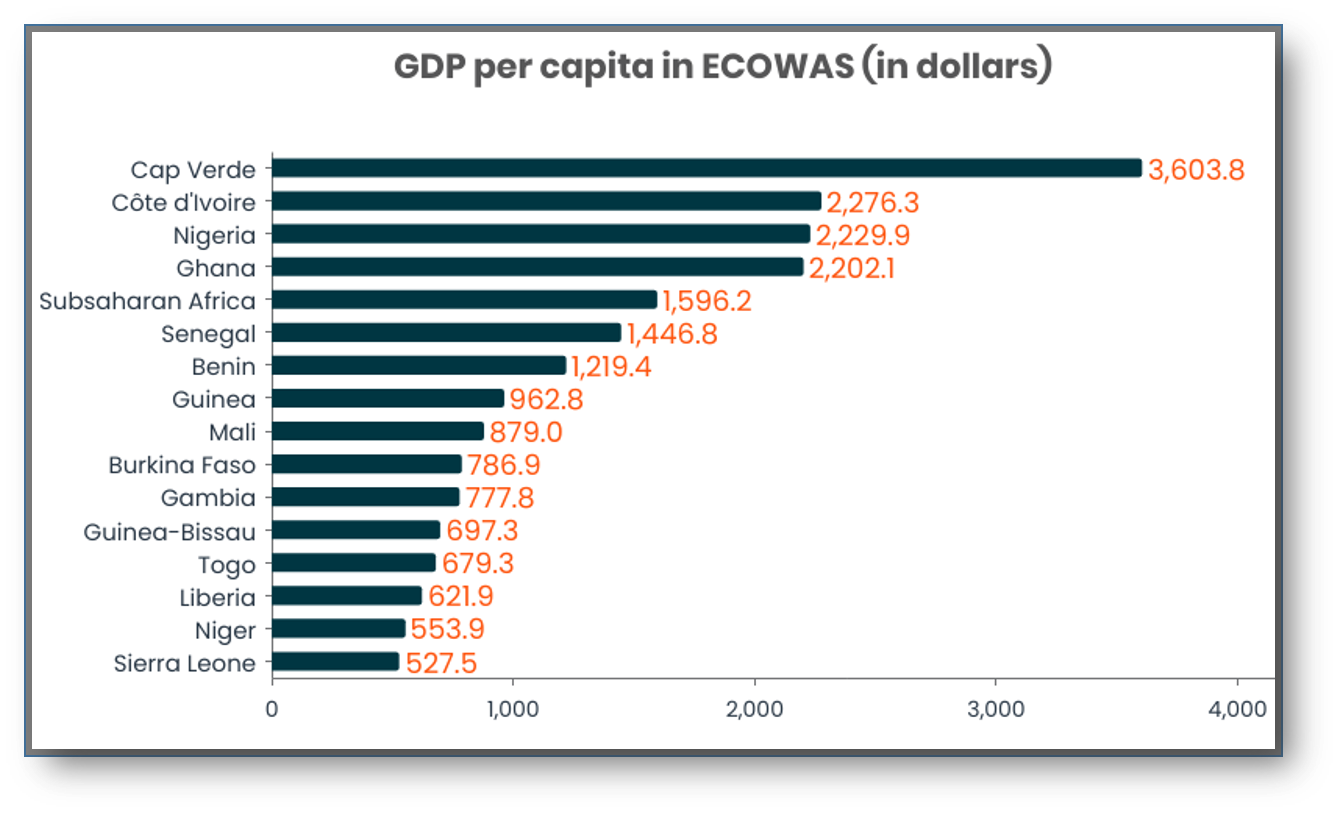
The country has invested US$1.7 billion in ports infrastructure since 20123 US$4.8 billion4 and US$10.8 into power generation and distribution5. Access to electricity increased from 33.3 percent in 2011 to 80 percent in 2020. The telecom sector received US$6 billion of investments during the same period. Today, Côte d’Ivoire has 30 240 km of fiber optic cables which reach 8 080 cities and communities. Mobile phone penetration 94,86 percent while access to the internet is at 74 percent.
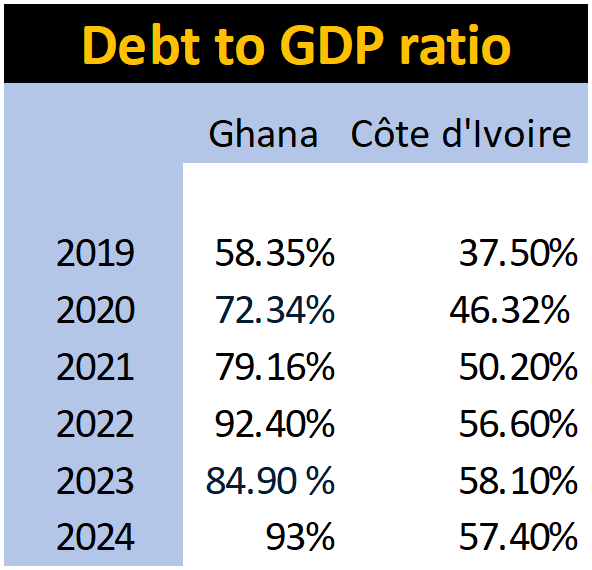
Opportunities and Challenges
Data from a 2023 report by the United Nations Trade and Development (UNTAD), show that Côte d’Ivoire attracted US$1.58 billion in foreign direct investments (FDI) inflows in 2022. This represents an increase of 15 percent year-on-year and above the level recorded before the pandemic. The total FDI stock was US$13.67 billion, representing 19.5 percent of the country’s GDP.
In another test of investor confidence, Côte d’Ivoire raised US$2.6 billion on the Eurobond market in January 2024. The issuance attracted over 400 investors, in an operation that generated an over-subscribed order book exceeding US$8 billion.
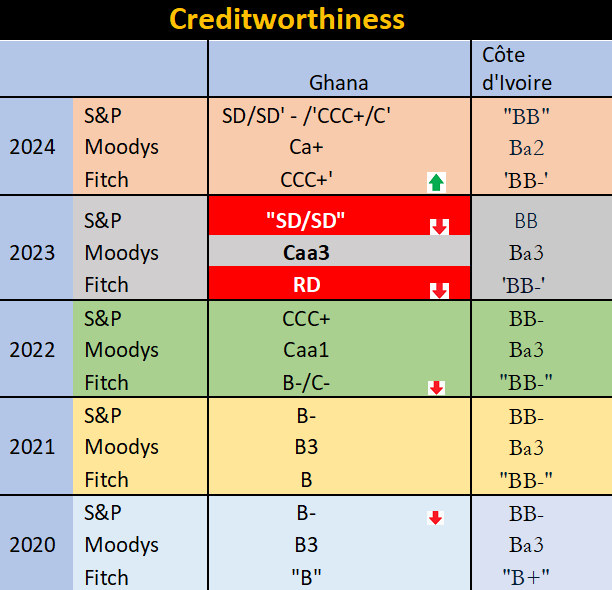
During the same period, and also according to UNCTAD, FDI inflows to Ghana declined by 39 percent year-on-year in 2022, amounting to USD 1.47 billion. Since Ghana defaulted on international debt on December 19th, 2022, the country has no access to international markets. However, the authorities have been able to lead a robust debt restructuring negotiations with domestic and international creditors. The goal is to attain debt sustainability, reduce fiscal deficit and restore confidence.
Côte d’Ivoire and Ghana share chronic economic challenges. The two countries export raw commodities with little to no added value. They then pay 50 percent more to import finished products made with the same commodities they produce. This is the case, for example, for refined petroleum, chocolate, aluminum and liquefied petroleum gas (LPG) and fertilizers. These trade patterns expose them to the risks stemming from the adverse economic conditions is their export destinations. Import dependence also distorts domestic competitiveness and cripples domestic manufacturing. Cross-border trade represents less than one percent of their respective regional trade. In addition, Ghana must factor the negative effects of a constantly depreciating currency.
Despite these issues and the economic performance of Côte d’Ivoire performance gap, the two countries will gain from synchronized economic policies and industrial strategies. Instead, and for decades, they have ignored each other and even behaved as competitors. However, in 2018, they set up ‟The Côte d’Ivoire–Ghana Cocoa Initiative” to influence global cocoa prices and the chocolate market. Also, in October 2024, Presidents Allassane Ouattara and Nana Ado inaugurated a new bilateral ‟Strategic Partnership Agreement” in Abidjan. The partnership aims to strengthen economic ties, reinforce security cooperation and also to harmonize regional and international policies. Ghana and Côte d’Ivoire are backing the creation of a West African single currency: The ECO.
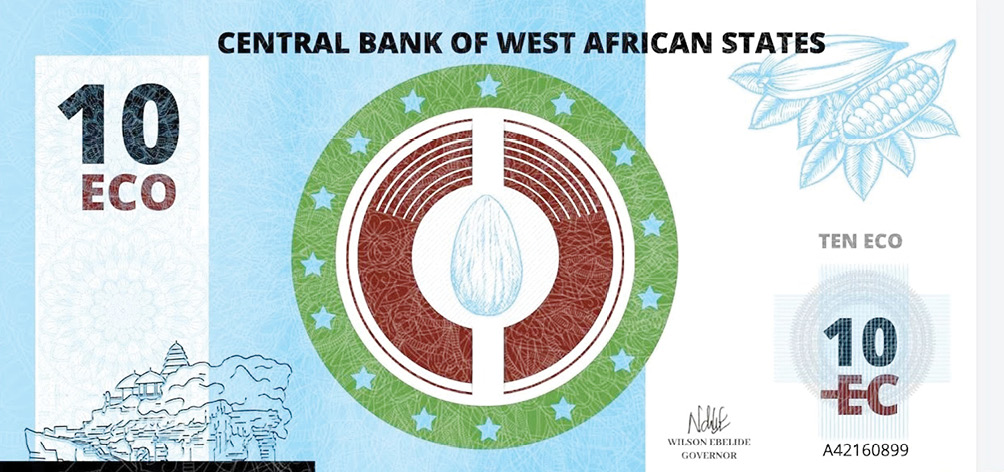
Related Articles
BIBLIOGRAPHY
1❩ https://www.dgf.gouv.ci/images/app/contenu/169/standard-and-poor-s-mai-2024.PDF
2❩ https://www.worldbank.org/en/country/cotedivoire/overview#:~:
text=Over%20the%20past%20decade%2C%20C%C3%B4te,States%20(ECOWAS)%20and%20elsewhere.
3❩ https://www.gouv.ci/_actualite-article.php?recordID=14467&d=1
4❩ https://www.gouv.ci/_actualite-article.php?recordID=16787
5❩ https://www.gouv.ci/_actualite-article.php?recordID=13000
